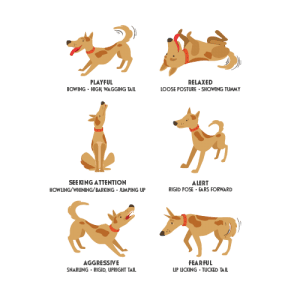Just like us humans, animals experience a wide range of emotions and have their own unique ways of expressing them. In this post, we’ll explore positive and negative body language and their meanings in cats and dogs. Understanding these signs will help you build a strong and lasting bond with your furry family member.
Cat Behaviors

Most cats aren’t shy about showing their feelings, but are you reading their body language right? Let’s take a look at a few of the most common cat behaviors and their meanings.
Trusting: If your kitty trusts you, they’ll show signs that they’re comfortable around you. A trusting cat will have a relaxed body posture and tail. They may also roll over and present their tummy to you. Kneading (sometimes referred to as making biscuits) is when a cat pushes their front paws up and down. This is another excellent sign that your cat is at ease and trusts you.
Frightened: When your cat is frightened, you may notice them cowering and tucking their tail between their legs. Especially fearful kitties may even tremble or run away and hide. Hair standing on end is another classic sign of fear in cats. Frightened felines may also have an arched back and flattened ears. Fun fact: vets call this “airplane ears”.
Irritated: Irritated cats will often hold their body in a rigid pose with their tail held out stiffly behind them. Unlike dogs, if your cat is wagging their tail it’s a good sign that they’re unhappy! Irritated cats may also growl, hiss, or spit to express their anger. Other signs to look out for include direct eye contact and dilated pupils.
Content: It’s usually pretty easy to tell when your feline friend is feeling happy and content. Common signs include a relaxed body posture, gentle purring, and slow blinking. According to Animal Planet’s Cat Daddy, the slow blink is the “Cat I Love You”. So, why not try returning your cat’s blinks to show them how much you care?
Predatory: If your cat is feeling predatory, they’ll often be poised to pounce. You may also notice that their ears or tail are twitching. This is when it pays to be careful, as a predatory cat may scratch or bite.
Rubbing and Scent Marking: Cats rub against objects (or people) to claim ownership and spread their scent. So, next time your cat headbutts or nuzzles you, you’ll know exactly what they’re up to!
Dog Behaviors
Just like cats, dogs have their own ways of expressing how they’re feeling. Keep reading for a few common dog behaviors and their meanings.
Relaxed: Rolling over and showing their tummy when they’re relaxed is one behavior that dogs share with cats. Happy and content pups will also have a loose posture, floppy ears, and soft eyes.
Alert: A rigid pose, wide eyes, and ears pointed forward are all signs that your dog is alert and on guard. You’ll usually see this behavior when your dog has heard a noise or detected something that may be of interest.
Aggressive: Snarling and growling may be easy to spot, but other signs of aggression in dogs can be more subtle. Keep a lookout for signs like flattened ears, a stiff tail, wide eyes, and dilated pupils. Always make sure to back off and give your dog plenty of space if you notice aggressive body language.
Fearful: If your dog is afraid, they may tuck their tail between their legs and lower their body. It’s also important to note that some dogs will respond to fear with aggression. Be alert for signs of fearful aggression like wide eyes and flattened ears.
Playful: Bowing, excited barking, a high, wagging tail, and an open mouth with tongue hanging out are all signs that your pup is ready to play. You’ll typically see this type of behavior when your dog gets their paws on a favorite toy or it’s time to head out on a walk.
Seeking Attention: If your dog wants to get your attention, you’ll probably know all about it! Common attention-seeking behaviors in dogs include jumping up, howling, whining, and barking. Some dogs will even bring their pet parents toys in an effort to instigate playtime.
Concerned about your pet’s fearful or anxious behavior? Always seek out a professional opinion from a qualified veterinarian. You can go ahead and schedule your pet’s checkup directly from the PetDesk app.









